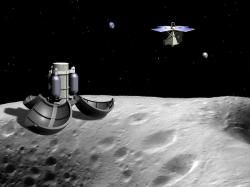From Physorg.com:
With a typical launch cost for a spaceship around $20 million, it’s difficult to practically conceive of a space industry beyond federally funded agencies. Nevertheless, many people believe that expanding space travel—whether for research purposes, entertainment, or even colonization—is not impractical. Bridging the economic hurdle may be technologies such as the maglev launch assist. According to an analysis, the cost of launching payloads into the low earth orbit with maglev may be achieved with only hundreds of dollars per pound (John Olds and Peter Bellini).
Most recently, researchers in a group including Wenjiang Yang and his colleagues from the Beijing University of Aeronautics and Astronautics and the Chinese Academy of Sciences have investigated the possibility of the “Maglifter,” a maglev launch assist vehicle originally proposed in the 1980s. In this system, a spaceship would be magnetically levitated over a track and accelerated up an incline, lifting off when it reaches a velocity of 1,000 km/hr (620 miles/hr). The main cost-saving areas would come from reduced fuel consumption and the reduced mass of the spaceship.
Continue reading “Superconducting Maglev Launch Technology” »








